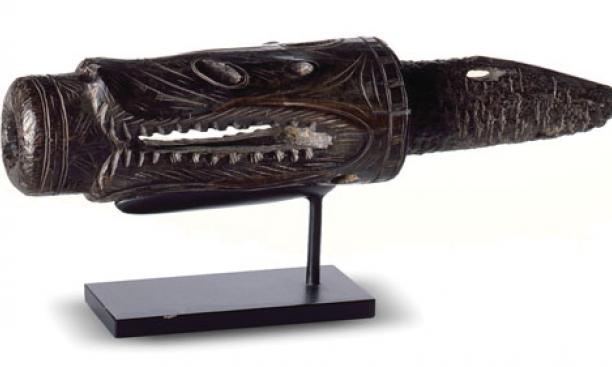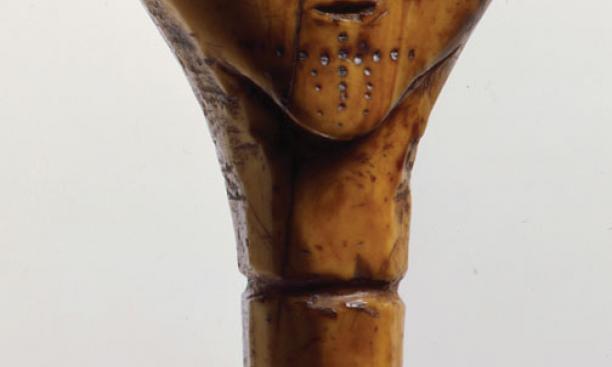


An upcoming exhibition at the Princeton University Art Museum displays objects unearthed by modern Native American “subsistence diggers” — people who sell artifacts to support themselves — raising ethical issues about provenance, ownership, and effects on the art market. But the museum tackles these questions head-on in the exhibit, “Gifts from the Ancestors: Ancient Ivories of Bering Strait,” on display Oct. 3 through Jan. 10.
The exhibit includes 200 objects from both the Russian and Alaskan sides of the Bering Strait, mainly carved from walrus tusks dating from A.D. 100 to 1200. They range from hunting objects used to harpoon seals to human figurines and household items such as carving instruments.
In addition to items unearthed and removed without documentation by subsistence diggers on Alaska’s St. Lawrence Island in the Bering Sea, the show includes items excavated by archaeologists with the collaboration of Russian and Alaska Native communities. Some items have unknown provenance.
Unlike some Native American communities that in recent years have sought to reclaim artifacts excavated from their land or that resist any new excavation, believing that items are sacred and should remain in the ground, many people in communities on St. Lawrence Island take a different position on the objects from ancient burial sites and households. They view the items as gifts left by their ancestors that can be sold to buy heating oil, boats, ammunition, and other supplies that they need to survive today. Not all people on St. Lawrence Island feel the same way, however; some feel a sense of loss that items end up in unknown places and hands, and some refuse to dig.
From the start, said Bryan R. Just, the Peter Jay Sharp ’52 Curator and Lecturer in the Art of the Ancient Americas and a co-curator of the exhibit, the idea of the exhibition was not only to examine the objects for what they say about ancient peoples and their culture, but also to study a range of issues: ownership of cultural property; the different paths the objects have taken to the museum; the various perspectives of native peoples about these objects and what they mean to the communities; and the role of the art market and the responsibility of museums.
Just hopes to explore these ideas in a panel discussion Oct. 3 in McCosh 10 with Alaska Natives and scholars on cultural heritage and patrimony issues, in the exhibit’s catalog, and on its Web site (artmuseum.princeton.edu/gifts). A video installation planned for the exhibit will feature Alaskan whale hunters, St. Lawrence elders and contemporary artisans, and scholars.
The art market recently has taken a keen interest in these primitive art objects. “They garner very high prices at art auctions,” said Just — which is part of the dilemma in exhibiting art dug up by subsistence diggers that is in private collections. Museums could be driving up the market value of those items — and further encouraging undocumented subsistence digging, he said. When objects are dug up without scientific documentation, there is no record kept of where they were found or what else was found with a particular object.
During the course of planning the exhibit, the museum consulted with representatives from Alaska Native communities on the issues raised and how to exhibit the objects and tell the story. At one meeting representatives raised concerns about displaying objects in a vacuum, said Just. He and the co-curators have infused the catalog and exhibition installation with information about those who made the objects.
Gaining permission for loans was a complicated process — in some cases involving tracing the path of the objects back to the original village to get permission both from the community and the museums that currently house the items. There were some dead ends. A museum at the University of Alaska, Fairbanks, which holds the largest collection of archaeologically excavated items from the Bering Strait region in North America, refused to loan any items from its collections because it felt any exhibition would drive up the market and cause more digging.
Despite the potential pitfalls of an exhibit like this, Just sees value in it. “We can’t forget about these pieces because they don’t have archaeological context. They are still a clue to the past. Many of them are marvelous works of art, and to deny their existence is to limit our understanding — doing so you make an ethical statement, but at the detriment of scholarship.” Another aim of the exhibit, he added, is “repatriation of knowledge.” By publishing information about the objects, and sending catalogs back to the villages that collaborated on the exhibit, he said, “we are in some way reconnecting people with this heritage.”
DRY ICE: ALASKA NATIVE ARTISTS AND THE LANDSCAPE, Oct. 1, Arts Council of Princeton (102 Witherspoon St.) An exhibition of works by contemporary artists from Alaska.
PANEL DISCUSSION: ANCIENT LIFEWAYS, CURRENT CONCERNS, Oct. 3, 2–6 p.m., McCosh 10 Alaska Natives and scholars will discuss cultural heritage and patrimony and the effects of climate change on subsistence economies in the Bering Strait region.
FAMILY DAY: A CELEBRATION OF ALASKAN NATIVE CULTURE, Oct. 4, 12–4 p.m., Hinds Plaza (Witherspoon Street in front of the Princeton Public Library) Twenty-five Alaska Native artists, athletes, storytellers, and performers will demonstrate traditional crafts, games, music, and dance.
